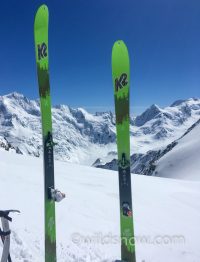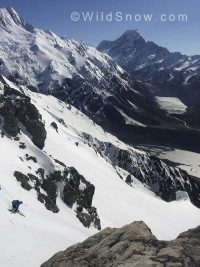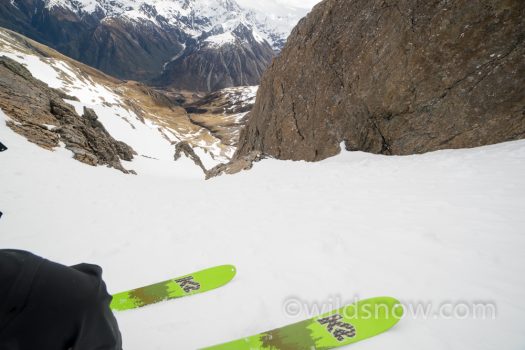For me, spring skiing means big descents, buttery corn, and hanging out under a summer sun after it’s all done. Springtime also means skinny skis. Narrow waisted sticks save significant weight on the up, and are often more fun on the down than their heftier winter cousins.
I used a pair of K2 Wayback 88s for spring season skis around six years ago. They certainly weren’t the lightest thing out there, but they worked well, especially on the down. I used them to ski Denali, and they supported quite a few ski descents in Washington and Colorado.
(This post sponsored by our publishing partner Cripple Creek Backcountry.)
Over the last few years I’ve owned a variety of skinny skis for spring skiing: all around 80-90 underfoot. Recently I’ve drifted towards skis that utilize ultralight construction techniques to achieve remarkable reductions in weight. Unfortunately strength and durability are sometimes compromised in pursuit of cutting grams (I’ve broken a pair). And, ultra-light skis tend not to ski well in unfavorable conditions. So I decided to somewhat reverse the weight reduction program and return to more traditionally constructed planks for the vernal season.
I remembered how much I loved my old Waybacks, and decided to give the latest build a try on our spring skiing trip to New Zealand. K2 has now expanded the Wayback line into four skis, the Wayback 105, 96, 88, and 78. Many of these skis are similar to older sticks, for example, the 104 is an update to the venerable Coomback 104. The 88 is very similar to the same Wayback 88 that has been in the line for years. The graphics are new, and the top sheet is textured to prevent snow from adhering. Also, the skis have a hybrid cap/sidewall construction. Other than that they are similar to my original pair. The dimensions and rocker/camber profile are identical.
Any ski under 100mm underfoot feels skinny to me. I generally only ski such skis in the spring, or when I really want to save weight. I’ve found that a ski around 88mm or so at the waist is a good spring ski width. Any skinnier and you really notice the wasp waist when skiing slush, or anything other than corn or hard snow. Conversely, any wider and I start to notice the loss of edge hold, and added weight.
I first tried the skis on beautiful corn at Temple Basin, New Zealand. As soon as I carved the first turn, I was reminded why they haven’t changed these things in so many years. Waybacks work, really well. The shape and width is perfect for ripping long radius turns down buttery corn. The slight rocker in the tip makes for easy short radius turns as well.
We encountered icy snow later that day, and would find more not-so-soft snow throughout the trip. The narrow width and sidewall construction provided excellent edge hold. The skis aren’t exceptionally stiff, although they are sturdy enough to instill confidence while still being forgiving in difficult snow.
New Zealand is outstanding in many ways: mountains, scenery, people. Good snow often doesn’t make it on the list. We encountered all sorts of weird white stuff down there — ice, heavy powder, breakable crust, and rain-saturated mush. It was an excellent stage to test skis, if nothing else.
On the ski down from the Tasman Saddle Hut, we encountered some of the worst snow I’ve ever seen. Wet snow had fallen for several days, and then it got cold, resulting in thick breakable crust above two feet of horrendous slush. This was almost impossible for me to “ski,” especially with the low girth of the Waybacks. Later in the trip we encountered similar snow, except it was slightly less breakable and less slushy. In that scenario, the slight tip rocker in the Waybacks helped make the snowpack survivable.
The only drawbacks with the Waybacks are inherent to what make these skis excel. They are indeed a bit heavier than many modern touring skis of similar size. However, they are still light enough. The only snow condition I’ve encountered where I have wished for other skis was slush and heavy pow as described above. A narrow 88 underfoot ski isn’t going to perform very well in those conditions, no matter what.
2017 174 Wayback Ski Weight (verified on postal scale): 1404 grams for one ski, 1364 grams for the other. 2768 grams per pair (Making average weight per ski, 1384 grams.)
For reference, here are previous posts we’ve done on past versions of the Wayback 88:
Baker SL and Wayback Comparo
Wayback skis for Denali
Wayback and Talkback Review
We’ve not found extensive online shopping options for K2 backcountry skis. If you’re looking for planks similar to the Wayback 88, consider the Atomic Backland options and other skis of similar width available at Cripple Creek. You can find a few K2 backcountry model skis at Backcountry.com .
Also see our 2018 Ultimate Quiver ski review for lots of “80s” ski options.
Louie Dawson earned his Bachelor Degree in Industrial Design from Western Washington University in 2014. When he’s not skiing Mount Baker or somewhere equally as snowy, he’s thinking about new products to make ski mountaineering more fun and safe.



